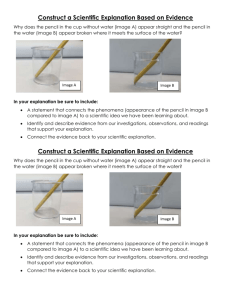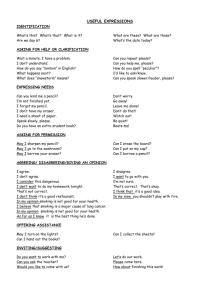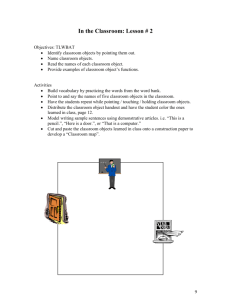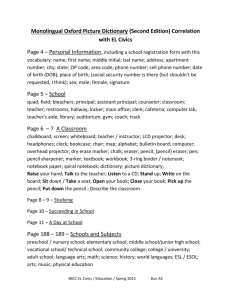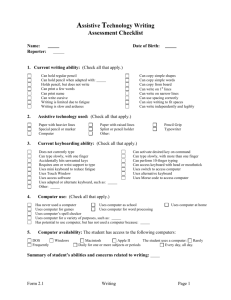ACADEMY OF HEALTH SCIENCES, US ARMY
advertisement
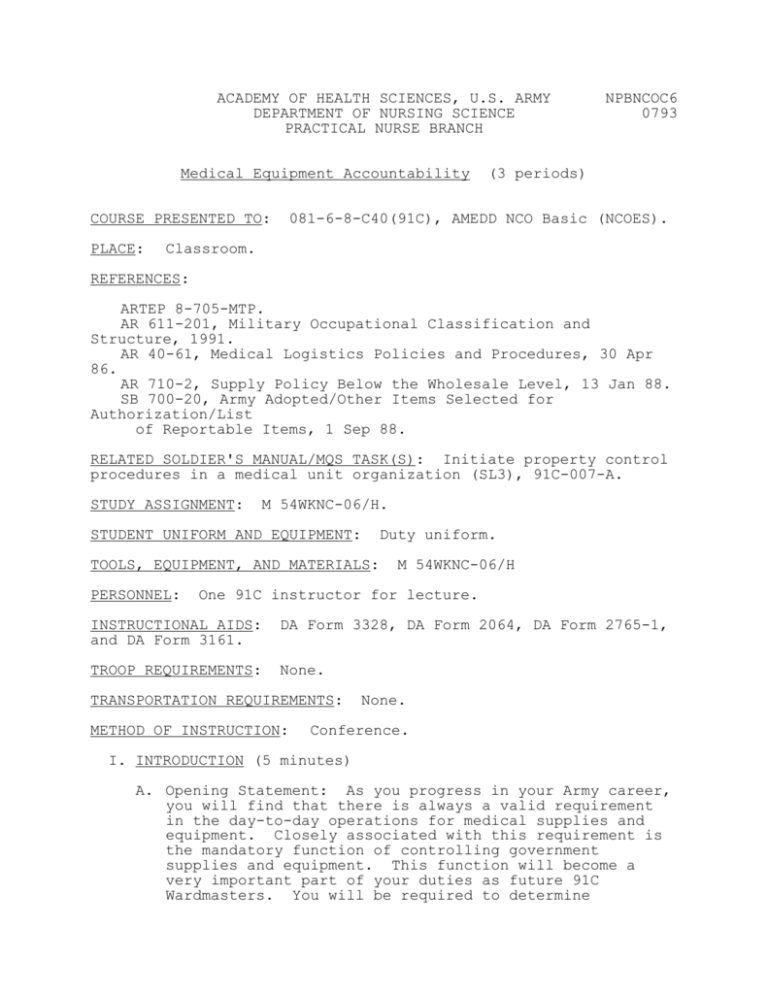
ACADEMY OF HEALTH SCIENCES, U.S. ARMY DEPARTMENT OF NURSING SCIENCE PRACTICAL NURSE BRANCH Medical Equipment Accountability COURSE PRESENTED TO: PLACE: NPBNCOC6 0793 (3 periods) 081-6-8-C40(91C), AMEDD NCO Basic (NCOES). Classroom. REFERENCES: ARTEP 8-705-MTP. AR 611-201, Military Occupational Classification and Structure, 1991. AR 40-61, Medical Logistics Policies and Procedures, 30 Apr 86. AR 710-2, Supply Policy Below the Wholesale Level, 13 Jan 88. SB 700-20, Army Adopted/Other Items Selected for Authorization/List of Reportable Items, 1 Sep 88. RELATED SOLDIER'S MANUAL/MQS TASK(S): Initiate property control procedures in a medical unit organization (SL3), 91C-007-A. STUDY ASSIGNMENT: M 54WKNC-06/H. STUDENT UNIFORM AND EQUIPMENT: TOOLS, EQUIPMENT, AND MATERIALS: Duty uniform. PERSONNEL: M 54WKNC-06/H One 91C instructor for lecture. INSTRUCTIONAL AIDS: and DA Form 3161. DA Form 3328, DA Form 2064, DA Form 2765-1, TROOP REQUIREMENTS: None. TRANSPORTATION REQUIREMENTS: METHOD OF INSTRUCTION: None. Conference. I. INTRODUCTION (5 minutes) A. Opening Statement: As you progress in your Army career, you will find that there is always a valid requirement in the day-to-day operations for medical supplies and equipment. Closely associated with this requirement is the mandatory function of controlling government supplies and equipment. This function will become a very important part of your duties as future 91C Wardmasters. You will be required to determine NPBNCOC6 0793 everything from required quantities, items to be requested, receipt and storage of items, and maintenance of accountability records. Thus, you can see the importance of accurate property control procedures in a medical unit organization. B. Objectives. 1. Terminal Learning Objective Determine requirements to account for inventory and replace mission-essential supplies and equipment IAW AR 40-61. 2. Enabling Learning Objectives a. Given a list of definitions, select the definitions for medical equipment accountability and responsibility IAW AR 710-2 and AR 40-61. b. Given a list of types of responsibility, select the four types of responsibility related to medical equipment accountability IAW AR 40-61. c. Given a list of points, select the key points which should be followed when conducting an inventory IAW AR 40-61. d. Given the necessary equipment, select the proper procedure for accountability of medical items on DA Form 3328 IAW AR 710-2. e. Given a list of storage periods and a list of medical items, match each item to its storage period IAW AR 40-61. C. Class Procedure and Lesson Tie-in: As a Wardmaster, you hold the keys to the success of your troops' mission in your hands--supplies and equipment. Even General Patton couldn't perform tasks at hand without proper materials. This lecture will help you learn to use the medical materiel system to obtain and maintain critical supplies and equipment. 2 NPBNCOC6 0793 II. EXPLANATION (125 minutes). A. Definitions. 1. Accountability is the obligation of an individual officially designated to maintain records of item balances and/or dollar values as prescribed by current regulations, showing authorized receipts, issues, adjustments, and available balances on hand. 2. Responsibility is the obligation of an individual with respect to the proper custody, care, and safekeeping of government property entrusted to his possession or supervision. B. Types of Responsibility. 1. Command responsibility. a. Command responsibility is the obligation of a commander to ensure the proper care, custody, and safekeeping of all government property within his command. NOTE: Command responsibility is inherent in the command and cannot be delegated. b. Command responsibility includes: (1) Ensuring the security of all unit property, whether in use or storage. (2) Observing subordinates to ensure that their activities contribute to the proper custody, care, use, and safekeeping of all unit property. (3) Enforcing all security, safety, and accounting requirements. (4) Taking administrative or disciplinary measures when necessary to enforce supply accountability or supply discipline. 2. Supervisory responsibility. a. Supervisory responsibility is the obligation of a 3 NPBNCOC6 0793 person for care and safekeeping of government property issued to or used by his subordinates. b. It is inherent in all supervisory positions and is not based upon signed receipts or responsibility statements. c. Supervisory responsibility includes: (1) Providing proper guidance and direction. (2) Enforcing all security, safety, and accounting requirements. (3) Maintaining an environment for the proper care and use of government property. QUESTION: ANSWER: What is the first responsibility of a supervisor? To provide proper guidance and direction. 3. Direct responsibility. a. Direct responsibility is the relationship between a person and the property for which he/she has been formally tasked to provide care and custody. b. Direct responsibility results from acceptance of property on a hand receipt. 4. Personal responsibility. a. Personal responsibility is the responsibility of a person for the property in his physical possession. b. Personal responsibility is a serious obligation. C. Key Points Which Should Be Followed When Conducting an Inventory. 1. Account for all property listed on the hand receipt. 2. Check all items to make sure the quantity on the hand receipt agrees with the quantity physically on hand. 3. Visually check all items for serviceability using 4 NPBNCOC6 0793 supply catalogs or other applicable publications and note any deterioration. 4. Physically check the completeness of all end items, sets, kits, and outfits (SKO). Use the appropriate publications to identify the components which comprise or complete the end item or SKO. 5. Report any damaged items to the unit supply so that maintenance can be accomplished or turn-in credit can be obtained. 6. Physically verify any serial numbers listed on the hand receipts against those actually on your equipment. 7. Ensure that all component shortages, other than consumable items, are listed on a shortage annex or component listing. 8. Make a list of any differences between the hand receipt quantity and the quantity physically on hand. D. Proper Procedure for Accountability of Medical Items (Property Book). 1. There is a page for each nonexpendable item authorized for the organization. 2. Shows identification and management information for each item. 3. Shows date, document number, quantity gained or lost, and the current balance on hand for each item. 4. Shows location and serial numbers, if applicable, of the item within the organization. NOTE: Direct students through preparation of DA Form 3328 to include pen and pencil entries. 5. Preparation of DA Form 3328. a. Date posted--enter Julian date the page is prepared (ink). 5 NPBNCOC6 0793 b. Balance--enter "0" on balance from old page (ink). c. UIC--enter unit identification code (ink). d. Authority--enter authorization document (pencil). e. Stock number--enter stock number of the item (ink). f. UI--enter unit of issue (pencil). g. LIN--enter line item number as shown in SB 700-20; if no LIN in SB 700-20, enter nonstandard LIN from the authorized document in pencil. h. ERC--enter equipment readiness code in pencil. i. Required Allowance (Alw)--enter the quantity from the required column of the modification table of organization and equipment (MTOE), tables of distribution and allowances (TDA), or joint table of allowances (JTA) (pencil). j. FICC--enter the reportable item control code from SB 700-20 (pencil). k. LCC--enter the logistics control code from SB 70020 (pencil). l. ECC--enter the equipment category code (pencil). m. Item description--enter item nomenclature (pencil). QUESTION: number? ANSWER: What type of writing material is used to write a stock Ink. E. Storage Periods. NOTE: Shelf life is used only when referring to expiration-dated items. 1. Type I shelf-life items. 6 NPBNCOC6 0793 a. Items of supply having a definite (nonextendable) storage period. b. Identified by "01." c. For example, a controlled drug, Valium. 2. Type II shelf-life items. a. Items of supply having a definite storage period, but may be extended after a prescribed inspection. b. Identified by "02." 3. Estimated storage-life items. a. Items of supply with an estimated storage period during which time the item is expected to retain its serviceable qualities. b. Identified by "03." 4. Minimum shelf-life items. a. Items of supply with a minimum shelf life that is acceptable for depot procurement. b. Expiration date depends on the manufacturer. F. Questions from Students. III. SUMMARY (5 minutes). A. Review of Main Points. 1. Definitions. 2. Types of responsibility. 3. Key points which should be followed when conducting an inventory. 4. Proper procedure for accountability of medical items property book. 5. Storage periods. B. Closing Statement: Any military unit, whether it is an 7 NPBNCOC6 0793 intensive care unit (ICU) in a medical center or surgical ward in a combat support hospital, is dependent upon accurate property control. As you can now see, property control can only be achieved through proper maintenance of all property records. It will be up to you, as a Wardmaster, to perform these duties in an outstanding, conscientious manner. 8
